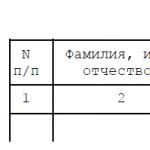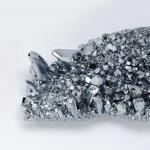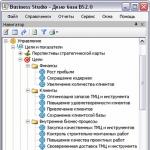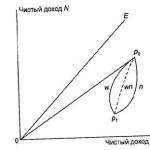How is osmium mined? Secrets of untold riches. We sell, but not to everyone
If from a practical point of view, element No. 76 among other platinum metals looks quite ordinary, then from the point of view of classical chemistry (we emphasize classical inorganic chemistry, and not the chemistry of complex compounds) this element is very significant.
First of all, it, unlike most elements of group VIII, is characterized by a valence of 8+, and it forms the stable tetroxide OsO 4 with oxygen. This is a peculiar compound, and, apparently, it is no coincidence that element No. 76 received a name based on one of the characteristic properties of its tetroxide.
Osmium is detected by smell
Such a statement may seem paradoxical: after all, we are not talking about a halogen, but about a platinum metal...
The history of the discovery of four of the five platinoids is associated with the names of two English scientists, two contemporaries. William Wollaston in 1803...1804 discovered palladium and rhodium, and another Englishman, Smithson Tennant (1761...1815), discovered iridium and osmium in 1804. But if Wollaston found both of his “own” elements in that part of raw platinum that dissolved in aqua regia, then Tennant was lucky when working with the insoluble residue: as it turned out, it was a natural alloy of iridium with osmium.
The same residue was also studied by three famous French chemists - Collet-Descoti, Fourcroix and Vauquelin. They began their research even before Tennant. Like him, they observed the release of black smoke when raw platinum was dissolved. Like him, they, by fusing the insoluble residue with caustic potassium, managed to obtain compounds that were still able to be dissolved. Fourcroix and Vauquelin were so convinced that there was a new element in the insoluble residue of raw platinum that they gave it a name in advance - pten - from the Greek πτηνος - winged. But only Tennant managed to separate this residue and prove the existence of two new elements - iridium and osmium.
The name of element #76 comes from the Greek word οσμη, which means “smell.” An unpleasant, irritating odor, similar to both the smells of chlorine and garlic, appeared when the product of fusion of osmiridium with alkali was dissolved. The carrier of this smell turned out to be osmium anhydride, or osmium tetroxide OsO 4. Later it turned out that osmium itself could smell just as bad, although much weaker. Finely ground, it gradually oxidizes in air, turning into OsO 4 ...
Osmium metal
Osmium is a tin-white metal with a grayish-blue tint. It is the heaviest of all metals (its density is 22.6 g/cm3) and one of the hardest. However, osmium sponge can be ground into powder because it is fragile. Osmium melts at a temperature of about 3000°C, and its boiling point has not yet been precisely determined. It is believed to lie somewhere around 5500°C.
The great hardness of osmium (7.0 on the Mohs scale) is perhaps one of its physical properties that is most widely used. Osmium is introduced into the composition of hard alloys that have the highest wear resistance. In expensive fountain pens, the tip of the pen is soldered from alloys of osmium with other platinum metals or with tungsten and cobalt. Similar alloys are used to make small parts of precision measuring instruments that are subject to wear. Small - because osmium is not widespread (5·10–6% of the weight of the earth’s crust), scattered and expensive. This also explains the limited use of osmium in industry. It goes only to places where a big effect can be achieved with a small amount of metal. For example, in the chemical industry, which is trying to use osmium as a catalyst. In hydrogenation reactions of organic substances, osmium catalysts are even more effective than platinum catalysts.
A few words about the position of osmium among other platinum metals. Outwardly, it differs little from them, but it is osmium that has the highest melting and boiling points among all the metals in this group, and it is the heaviest. It can also be considered the least “noble” of the platinoids, since it is oxidized by atmospheric oxygen already at room temperature (in a finely crushed state). Osmium is also the most expensive of all platinum metals. If in 1966 platinum was valued on the world market at 4.3 times more expensive than gold, and iridium at 5.3 times, then the same coefficient for osmium was 7.5.
Like other platinum metals, osmium exhibits several valencies: 0, 2+, 3+, 4+, 6+ and 8+. Most often you can find compounds of tetra- and hexavalent osmium. But when interacting with oxygen, it exhibits a valence of 8+.
Like other platinum metals, osmium is a good complexing agent, and the chemistry of osmium compounds is no less diverse than, say, the chemistry of palladium or ruthenium.
Anhydride and others
Undoubtedly, the most important compound of osmium remains its tetroxide OsO 4, or osmium anhydride. Like elemental osmium, OsO 4 has catalytic properties; OsO 4 is used in the synthesis of the most important modern drug – cortisone. In microscopic studies of animal and plant tissues, osmium tetroxide is used as a staining agent. OsO 4 is very poisonous, it is highly irritating to the skin, mucous membranes and is especially harmful to the eyes. Any work with this useful substance requires extreme caution.
Externally, pure osmium tetroxide looks quite common - pale yellow crystals, soluble in water and carbon tetrachloride. At a temperature of about 40°C (there are two modifications of OsO 4 with similar melting points), they melt, and at 130°C osmium tetroxide boils.
Another osmium oxide - OsO 2 - a black powder insoluble in water - has no practical significance. Also, other known compounds of element No. 76 have not yet found practical application - its chlorides and fluorides, iodides and oxychlorides, OsS 2 sulfide and OsTe 2 telluride - black substances with a pyrite structure, as well as numerous complexes and most osmium alloys. The only exceptions are some alloys of element No. 76 with other platinum metals, tungsten and cobalt. Their main consumer is instrument making.
How is osmium obtained?
Native osmium has not been found in nature. It is always associated in minerals with another platinum group metal - iridium. There is a whole group of iridium osmide minerals. The most common of these is nevyanskite, a natural alloy of these two metals. It contains more iridium, which is why nevyanskite is often called simply osmic iridium. But another mineral - sysertskite - is called osmium iridide - it contains more osmium... Both of these minerals are heavy, with a metallic luster, and this is not surprising - such is their composition. And it goes without saying that all minerals of the osmic iridium group are very rare.
Sometimes these minerals occur independently, but more often osmic iridium is part of native raw platinum. The main reserves of these minerals are concentrated in the USSR (Siberia, the Urals), the USA (Alaska, California), Colombia, Canada, and the countries of South Africa.
Naturally, osmium is mined together with platinum, but the refining of osmium differs significantly from the methods for isolating other platinum metals. All of them, except ruthenium, are precipitated from solutions, while osmium is obtained by distilling it off from volatile tetroxide.
But before distilling off OsO 4, it is necessary to separate iridium osmide from platinum, and then separate iridium and osmium.
When platinum is dissolved in aqua regia, the minerals of the iridium osmide group remain in the sediment: even this of all solvents cannot overcome these most stable natural alloys. To convert them into solution, the precipitate is fused with eight times the amount of zinc - this alloy is relatively easy to turn into powder. The powder is sintered with barium peroxide BaO 3 , and then the resulting mass is treated with a mixture of nitric and hydrochloric acids directly in a distillation apparatus to remove OsO 4 .
It is captured with an alkaline solution and a salt of the composition Na 2 OsO 4 is obtained. A solution of this salt is treated with hyposulfite, after which osmium is precipitated with ammonium chloride in the form of Fremy salt Cl 2 . The precipitate is washed, filtered, and then calcined in a reducing flame. This is how spongy osmium is not yet pure enough.
Then it is purified by treating with acids (HF and HCl), and further reduced in an electric furnace in a stream of hydrogen. After cooling, metal with a purity of up to 99.9% O 3 is obtained.
This is the classic scheme for obtaining osmium - a metal that is still used extremely limitedly, a metal that is very expensive, but quite useful.
The more, the more...
Natural osmium consists of seven stable isotopes with mass numbers 184, 186...190 and 192. An interesting pattern: the higher the mass number of the osmium isotope, the more common it is. The share of the lightest isotope, osmium-184, is 0.018%, and the heaviest isotope, osmium-192, is 41%. Of the artificial radioactive isotopes of element 76, the longest-lived is osmium-194, with a half-life of about 700 days.
Osmium carbonyls
In recent years, chemists and metallurgists have become increasingly interested in carbonyls - compounds of metals with CO, in which the metals are formally zero-valent. Nickel carbonyl is already quite widely used in metallurgy, and this allows us to hope that other similar compounds will eventually be able to facilitate the production of certain valuable materials. Two carbonyls are now known for osmium. Pentacarbonyl Os(CO) 5 is a colorless liquid under normal conditions (melting point – 15°C). It is obtained at 300°C and 300 atm. from osmium tetroxide and carbon monoxide. At normal temperature and pressure, Os(CO) 5 gradually transforms into another carbonyl of the composition Os 3 (CO) 12 - a yellow crystalline substance that melts at 224°C. The structure of this substance is interesting: three osmium atoms form an equilateral triangle with sides 2.88 Å long, and four CO molecules are attached to each vertex of this triangle.
Fluorides, controversial and uncontroversial
“Fluorides OsF 4, OsF 6, OsF 8 are formed from elements at 250...300°C... OsF 8 is the most volatile of all osmium fluorides, bp. 47.5°”... This quote is taken from Volume III of the “Concise Chemical Encyclopedia”, published in 1964. But in Volume III of “Fundamentals of General Chemistry” B.V. Nekrasov, published in 1970, the existence of osmium octafluoride OsF 8 is rejected. We quote: “In 1913, two volatile osmium fluorides, described as OsF 6 and OsF 8, were first obtained. This was believed until 1958, when it turned out that in fact they correspond to the formulas OsF 5 and OsF 6. Thus, OsF 8, which appeared in the scientific literature for 45 years, never actually existed. Such cases of “closure” of previously described connections are not so rare.”
Note that elements also sometimes have to be “closed”... It remains to add that, in addition to those mentioned in the “Concise Chemical Encyclopedia”, another osmium fluoride was obtained - the unstable OsF 7. This pale yellow substance decomposes at temperatures above –100°C into OsF 6 and elemental fluorine.
Osmium is a chemical element with atomic number 76. In D.I. Mendeleev’s periodic table of chemical elements, it is designated by the symbol Os (lat. Osmium). Under standard conditions it is a silvery-bluish brittle transition metal. Belongs to the group of platinum metals. It has a high density, comparable in this parameter only to iridium (the densities of Os and Ir are almost equal, taking into account the calculated error).
Story
Osmium was discovered in 1804 by the English chemist Smithson Tennant in the precipitate remaining after dissolving platinum in aqua regia. Similar studies were carried out by French chemists Collet-Descoti, Antoine Francois de Fourcroix and Vauquelin, who also came to the conclusion that the insoluble residue of platinum ore contained an unknown element. The hypothetical element was given the name pten (winged), but Tennant's experiments demonstrated that it was a mixture of two elements - iridium and osmium.
Named from ancient Greek. ὀσμή (smell), based on the sharp-smelling volatile oxide OsO 4 (reminiscent of ozone).
Receipt
Osmium is isolated from enriched raw materials of platinum metals by calcining this concentrate in air at temperatures of 800-900 °C. In this case, vapors of the highly volatile osmium tetroxide OsO 4 are quantitatively sublimated, which are then absorbed by the NaOH solution.
By evaporating the solution, a salt is isolated - sodium perosmate, which is then reduced with hydrogen at 120 °C to osmium:
Na 2 + 3H 2 = 2NaOH + Os + 4H 2 O.
In this case, osmium is obtained in the form of a sponge.
Properties
Physical
Osmium is a grey-bluish, hard but brittle metal with a very high specific gravity that retains its luster even at high temperatures. Due to its hardness, brittleness, low vapor pressure (the lowest of all platinum metals), and very high melting point, osmium metal is difficult to machine. Osmium is considered the densest of all chemical elements, slightly exceeding iridium in this parameter. The most reliable densities for these metals can be calculated from the parameters of their crystal lattices: 22.562 ± 0.009 g/cm³ for iridium and 22.587 ± 0.009 g/cm³ for osmium. When comparing different isotopes of these metals, 192 Os is the densest. The unusually high density of osmium is explained by lanthanide compression.
Chemical
When heated, osmium powder reacts with oxygen, halogens, sulfur vapor, selenium, tellurium, phosphorus, nitric and sulfuric acids. Compact osmium does not react with either acids or alkalis, but forms water-soluble osmates with molten alkalis. Reacts slowly with nitric acid and aqua regia, reacts with molten alkalis in the presence of oxidizing agents (potassium nitrate or chlorate), and with molten sodium peroxide. In compounds it exhibits oxidation states from −2 to +8, of which the most common are +2, +3, +4 and +8.
Osmium is one of the few metals that form polynuclear (or cluster) compounds. Polynuclear osmium carbonyl Os 3 (CO) 12 is used to model and study the chemical reactions of hydrocarbons on metal centers. Carbonyl groups in Os 3 (CO) 12 can be replaced by other ligands, including those containing cluster nuclei of other transition metals.
Most people believe that there is nothing more expensive than gold, silver and platinum in the world. But in fact, there are several substances whose price per gram exceeds that of the three metals listed above. We will look at one of them today. This is osmium, the price for 1 gram in rubles will impress any person.
In 1803, the English chemist Smithson Tennant discovered Os, finding it in a precipitate that appeared after the scientist dissolved platinum in aqua regia. At the same time, experiments were carried out in France, where chemists Vauquelin and Antoine DeFourcroy also identified an unknown element in the sediment remaining from the dissolution of platinum ore. At first, the new element was called “pten” (translated from Greek as “winged”). But further research made it possible to determine that this is not one element, but a mixture of two - iridium and osmium.
The new substances were officially documented in Tenant's message to the Royal Club of London in June 1804.
Physical properties
The substance has a gray-bluish color. The metal is very brittle, but has a high specific gravity. When exposed to critical temperatures, it always retains its natural color and shine.
Since the metal is hard and has a high melting point (3033 degrees Celsius), it is difficult to machine.
Chemical properties
The substance in powder form, when heated, reacts well with oxygen, sulfur elements, selenium, and phosphorus. Slowly interacts with aqua regia.

The metal is one of several substances that form cluster compounds.
Where is it mined?
Osmic iridium is mined in Siberia and the Urals in Russia; in Alaska and California in the USA; Australia (and the island of Tasmania); South African state. The last country on the list boasts the largest metal deposits on the planet.
More often found in combination with arsenic and sulfur. The amount of substance in ores is insignificant.
Osmium cost
The cost of one gram of this substance is 15-200 thousand dollars. The market price of the metal is several times lower. This high cost is due to the low level of Os production. It is simply not used on a large scale due to its enormous density. If we make a comparison: a half-liter bottle with the substance in question will be heavier than 12 liters of water. Osmium is one of the three most expensive metals in the world. Only Californian is more expensive, its production is less than a gram per year.
The metal in question is very difficult to mine, and the process takes more than 9 months. The substance is an isotope and has the appearance of a black powder consisting of small crystals. Although osmium is the densest substance on our planet, it is very fragile. The smell of the metal immediately resembles bleach and garlic. That is why it received such a name (stands for “smell”).

The metal is indispensable in scientific, medical and research activities, as it is a chemical catalyst and is used in the production of measuring instruments that provide data of the highest accuracy.
The only state that sells osmium is Kazakhstan.
Other facts
The metal melts at temperatures above 3000 degrees Celsius. The boiling point reaches almost 6000 degrees.
It was opened in a rather unusual way. Several substances were diluted in aqua regia and it was discovered that a precipitate had formed that had a not very pleasant odor.
Os is not used for making jewelry, since it does not have malleability and ductility - those properties for which jewelers value precious metals so much.
The substance is found in ore deposits. It can also be found in meteorites that have fallen to Earth. Some industries are in dire need of metal to make their products. It goes to them as secondary raw material, but it is still not cheap.
Metal is used only because of its incredible strength. Alloys to which osmium is added become incredibly wear-resistant. It only takes minimal doses of the substance to add to the alloy to make it very strong.
Where is it used?
Osmium isotope is used to make containers for storing nuclear waste. The substance is also used in the space industry. It also accelerates the synthesis of ammonia and organic matter. By the way, tungsten filaments contain the described metal.
Since the substance is famous for its strength, it is used in the manufacture of weapons. But recently, industry has been trying to abandon the use of metal due to its high cost and difficult processing.
Metal is used only in cases where success is 100% guaranteed.
Osmium oxide is used for medical purposes and in biology. Many implants and pacemakers are made with the help of the substance in question. The latter are made from platinum, which contains 10% osmium.

Fountain pens are often produced with tips made of the metal in question. Such products are more durable than samples with gold ends.
Interesting! If you make an alloy of osmium with aluminum, it will be incredibly ductile. It can be pulled out several times without any tearing of the substance.
When the pressure is above 770 GPa, electrons located in the inner orbitals will interact in osmium, but the structure of the metal will not change at all.
Methods for obtaining the substance
Osmium is most often stored in powder form. In this form, the metal easily reacts and can be heat treated without any difficulties. Os does not melt and cannot be branded if the metal is in its pure form.
Using electron (sometimes arc) rays, metal is produced into ingots. Single crystals are created using zone melting. But this manufacturing method is very expensive, and therefore the price of the created products is high. But there are unique people who know how to create crystals from powder. This is a long and complex process that requires a lot of energy, but there are still results.
It was previously said that osmium has an unpleasant odor. The substance tetroxide is widely used in medicine. It is jokingly called “beautiful and fragrant.” Tetroxide crystals can be made at home, but be careful as the substance is toxic.

For example, to kill a mouse with tetroxide, it takes 40 times less of this substance than hydrocyanic acid (considered a recognized poison against rodents). This damaging effect is explained by the fact that, upon entering the body, the substance instantly becomes metallic. This causes damage to the respiratory tract and vision. But despite this, OsO4 is widely used as a dye in the chemical industry.
How does Os affect the body of living beings?
The element is very harmful and toxic to biological beings. When osmium is inhaled, the lungs fail (swelling occurs), and the living creature develops anemia.
When even a small amount of the substance is in the air, an individual experiences tearing, pain in the eyes, and conjunctivitis may develop.
It becomes difficult to breathe, spasms in the bronchi and a metallic taste in the mouth appear. If a person is not removed from the affected area in time, he or she faces the risk of blindness, impaired functioning of the kidneys, nervous system, and gastrointestinal tract. Possible death.
Metal also affects the integrity of the skin. It turns black or green. Ulcers and blisters appear on it. The tissue begins to die.
You can be poisoned by osmium at work if the amount of this substance in the air is slightly exceeded. In many modern production facilities, osmium is present in the air, although, according to experts, its concentration in the air should not be present at all.
| Au | Pt | Ag | Pd | |
|---|---|---|---|---|
| 12,86 | 40,23 | 30,29 | 0,55 | 24,88 |
Table 1 - osmium price (1 g) in comparison with other precious metals (market).
Conclusion
Although osmium is considered one of the most expensive metals on the planet, its market price is not so high. For example, 1 gram of gold can be bought for 2000-2500 rubles. While osmium costs about 1800 rubles per gram.
The cost of osmium varies everywhere, but only Kazakhstan sells it at the cheapest non-market price. The fact is that not only osmium, but also its isotope (osmium 187) is traded on the world market. It is the second one that has an incredible cost, due to the difficulty of processing, separation from other isotopes and limited use.
Now it’s clear how much osmium 187 and regular Os cost at the market price. Ordinary Os is a mixture of isotopes.
The widespread opinion in everyday life that there is nothing more expensive than gold and platinum in the world is extremely erroneous. There are several types of metals of natural and artificial origin, prices that are difficult for the common man to imagine.
Our planet is rich in minerals, including metals. Their cost depends on several factors, namely: properties, quantity in the world, mining conditions. It follows from this that the rarer a metal is in nature, has many different useful properties and is extremely difficult to obtain, the cost of such a resource will be very, very high. Presents the top 10 most expensive metals in the world with their prices.
Top 10 most expensive metals in the world
10

Discovered in 1844, ruthenium was found in Ural ore. Natural reserves amount to about 5,000 tons. It belongs to the platinum family of metals. Due to its refractoriness and long-term wear, it is used in combination with platinum in the production of electrical contacts, as well as in the space industry. Ruthenium has also been used in jewelry production as an additive to special jewelry alloys. The metal is used in the manufacture of compass needles, and is used to coat ceramics and glass. Its cost is approximately $1.5 per 1 gram.

Next on the list of the most expensive metals is rhenium. This very rare, light silver-colored, high-density element is in great demand in the rocketry market. Rhenium was found in 1925; during its study, it was discovered that the metal has a very high melting point. Thanks to these properties, it is actively used in the production of rocket technology parts, as well as in the chemical industry. The largest producer is a Chilean company, because it is in this country that large reserves of this element are located. Price - $10.

Soft and light scandium has a silvery color with a characteristic yellowish tint. It was discovered in 1879 by chemist Lars Nilsson. The main deposits of the mineral that contain this element are located in Madagascar and Norway. Widely used in the manufacture of structures used in industries with ultra-high temperatures. But mainly it found application in the manufacture of sporting goods. The alloy combined with aluminum has increased strength and malleability. It is used in the production of multilayer X-ray mirrors. The cost of 1 gram of scandium is $12.

Externally similar to tin, iridium is one of the rarest and most expensive metals in the world. Distinctive properties are high density, refractoriness at the same time as fragility. This silvery-white platinum group element. The discovery of iridium belongs to the English scientist Tennant and took place in 1803. It is used only in alloys with other metals, for example, in internal combustion plugs, on electrodes and increases their service life. Also used in the manufacture of expensive feather pens. The price for 1 gram of iridium is $20.

Another noble representative of the platinum group is palladium. It was first isolated from platinum ore in 1803 by the chemist Wollaston, of English origin. An element with high ductility and malleability is actively used in the jewelry industry in combination with gold. Jewelry of various price categories is made from so-called white gold. Palladium is widely used for the manufacture of medical instruments and dentures due to its anti-corrosion properties. 1 gram of palladium is valued at $30.

A metal that has been valued since ancient times as one of the most expensive in the world is gold. Yellow color, increased plasticity, high density - these are the main distinctive properties of the element. We are accustomed to the fact that gold is primarily used for jewelry. But thanks to thermal conductivity and low resistance, the metal has become indispensable in the manufacture of electrical contacts. Used in electroplating, a layer of gilding of metals is applied to avoid corrosion, as well as to give finished products made from cheaper materials a more expensive look. The cost of 1 gram is $45.

The opinion that platinum and white gold are the same thing is wrong. Platinum is an independent metal and was initially underestimated. It is very rare in nature, and the largest deposit is in South Africa. The element is used in various industries. Jewelers use pure metal for jewelry. Added to alloys to make laboratory glassware resistant to high temperatures. Also used in special mirrors for laser technology. Coins were minted from platinum and orders were made during the Soviet era. The price of 1 gram is $70.

Rhodium opens the top three most expensive metals in the world. It's a hard metal. The element was discovered by scientist William Wollaston in 1803 while working with platinum. It is extremely rare, considering that about 30 tons of platinum are mined worldwide each year. Due to its high property of reflecting electromagnetic rays, it is used to cover the surface of mirrors. It has gained great popularity in jewelry, both in the form of products with precious stones and in electroplating for coating. Costs 1 gram – $225.





